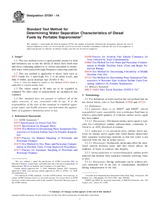Potřebujeme váš souhlas k využití jednotlivých dat, aby se vám mimo jiné mohly ukazovat informace týkající se vašich zájmů. Souhlas udělíte kliknutím na tlačítko „OK“.
ASTM D7261-14
Standard Test Method for Determining Water Separation Characteristics of Diesel Fuels by Portable Separometer
Automaticky přeložený název:
Standardní zkušební metoda pro stanovení vodě Rozdělovací Charakteristika motorové nafty by Portable Separometer
NORMA vydána dne 1.12.2014
Informace o normě:
Označení normy: ASTM D7261-14
Poznámka: NEPLATNÁ
Datum vydání normy: 1.12.2014
Kód zboží: NS-38022
Počet stran: 11
Přibližná hmotnost: 33 g (0.07 liber)
Země: Americká technická norma
Kategorie: Technické normy ASTM
Kategorie - podobné normy:
Anotace textu normy ASTM D7261-14 :
Keywords:
coalescence, diesel fuel, diesel fuel coalescer, DSEP rating, surfactant, water separation,, ICS Number Code 75.160.20 (Liquid fuels)
Doplňující informace
| Significance and Use | ||||||||||||||||||||||
|
5.1 This test method provides a measure of the presence of surfactants in diesel fuels, and can be performed in the field or in a laboratory. Like Test Method D3948 used for jet fuel, this test method can detect traces of some refinery treating chemicals left in fuel. It can also detect surface active substances added to or picked up by the fuel during handling from point of production to point of use. 5.2 Certain additives, which can act as weak surfactants, give a slightly reduced DSEP rating. Other substances which are strong surfactants give much lower DSEP ratings. 5.3 While filter separators have not been common in diesel fuel systems, they could become more prevalent with ULSD containing increased additive content to ensure clean, dry fuels in new engine designs. Weak surfactants, with slightly reduced DSEP ratings, do not affect the ability of filter separators to separate free water from the fuel. Strong surfactants give a much lower DSEP rating and adversely affect the ability of filter separators to separate free water from the fuel. 5.4 Results from this test method do not have a known relationship to the rate of water settling in tanks. 5.5 The Micro-Separometer instrument has a measurement range from 50 to 100. Values obtained outside of those limits are undefined and invalid. Note 2: In the event a value greater than 100 is obtained,
there is a good probability that light transmittance was reduced by
material contained in the fuel used to set the 100 reference level.
The material was subsequently removed during the coalescing portion
of the test, thus, the processed fuel had a higher light
transmittance than the fuel sample used to obtain the 100 reference
level resulting in the final rating measuring in excess of
100.
|
||||||||||||||||||||||
| 1. Scope | ||||||||||||||||||||||
|
1.1 This test method covers a rapid portable means for field and laboratory use to rate the ability of diesel fuels (both neat and those containing additives) to release entrained or emulsified water when passed through fiberglass coalescing material. 1.2 This test method is applicable to diesel fuels such as D975 Grade No. 1 and Grade No. 2 of all sulfur levels, and MIL-F-16884, naval distillate fuel (NATO F-76). Note 1: This test method is similar to Test Method
D3948 which is applicable to
aviation turbine fuels.
1.3 The values stated in SI units are to be regarded as standard. No other units of measurement are included in this standard. 1.4 This standard does not purport to address all of the safety concerns, if any, associated with its use. It is the responsibility of the user of this standard to establish appropriate safety and health practices and determine the applicability of regulatory limitations prior to use. |
||||||||||||||||||||||
| 2. Referenced Documents | ||||||||||||||||||||||
|




 Cookies
Cookies
